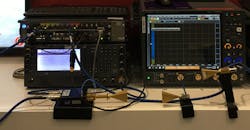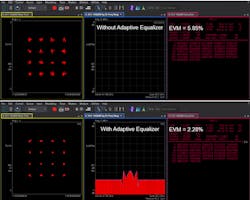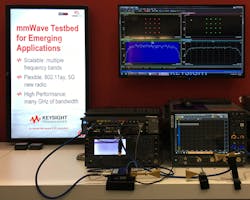Tackling Extreme Bandwidths for Emerging mmWave Applications
Download this article in PDF format.
Large swaths of contiguous millimeter-wave (mmWave) spectrum have opened in the U.S, offering opportunities to use these bands for very-high-data-throughput applications. However, testing mmWave hardware designed for high-data-throughput applications requires careful consideration to gain insight into the actual hardware performance when tested.
Increasing data throughput is possible employing several different methods. One method is to use higher symbol rates and more channel bandwidth. Higher-order modulation, such as 64-QAM, is possible if the radio’s performance is sufficient to support the higher-order modulation format.
To measure the radio performance under these conditions, a mmWave test-bed system’s performance should not be the dominant source of error; otherwise, it can mask the hardware’s true performance when testing the hardware. This article will discuss some of the considerations in designing and testing hardware for extreme-bandwidth applications and will highlight these considerations using a simulation case study.
A new research-and-development test bed will be presented, which leverages the latest advances in ultra-high-performance digital-oscilloscope technology. A 110-GHz UXR real-time oscilloscope is used to directly digitize and analyze extreme-bandwidth mmWave signals. The UXR’s maximum sampling rate is 256 Gsamples/s per channel (up to four channels) with 10 bits of vertical resolution. This new capability provides flexibility and scalability to address a multitude of mmWave frequency bands, extreme frequency bandwidths, and multiple channels to address demanding emerging mmWave test challenges.
Extreme Bandwidths for an Emerging mmWave Application: 802.11ay
802.11ay is the next generation of 802.11ad. Backwards-compatible with 802.11ad, 802.11ay has extended throughput, transmission range, and use cases. The requirement for the 802.11ay standard definition is to enable at least one mode of operation to support a maximum throughput of at least 20 Gb/s while maintaining or improving the power efficiency. It’s possible the technology could support speeds beyond 20 Gb/s and reach distances of approximately 1,000 feet. 802.11ay specifies a mandatory two-bonded channel configuration for 2 × 2.16 GHz of bandwidth, or 4.32 GHz, as well as optional channel-bonding configurations for 6.48 and 8.64 GHz of bandwidth.1
For a discussion of design and test considerations, we’ll use a signal centered at 61.56 GHz with a channel bandwidth of 8.64 GHz as an example of an extreme-bandwidth emerging mmWave application.
Extreme Bandwidth: Simulation Case Study
Achieving the performance required to support extremely wide bandwidths can be difficult. A simulation case study is used to help understand some of the key system performance considerations. Using simulation is convenient in helping to understand performance considerations and design tradeoffs. That’s because design impairments can easily be isolated to evaluate their impact individually as well as their contribution to the overall system performance, which can be difficult in the hardware testing phase. The simulation shown in this case study is a conceptual design to highlight key considerations and is not intended to represent an actual hardware design.
This simulation case study begins with a simple upconverter design consisting of a modulation IF source with a center frequency of 5 GHz modeled with Keysight‘s SystemVue design software (Fig. 1). The modulation type can be set to QPSK, 16 QAM, or 64 QAM. The symbol rate is set to 7.04 GHz with a root-raised-cosine (RRC) filter alpha of 0.22. These settings are “802.11ay-like” in their values, corresponding to the 802.11ay 8.64-GHz channel bandwidth configuration.
1. Shown on the left is a simple upconverter design that consists of a modulation IF source with a center frequency of 5 GHz. The constellation diagram is on the right.
The modulated IF is upconverted to 61.56 GHz using a mixer with a high-side local oscillator (LO). The LO source frequency is 33.28 GHz, followed by a times-two multiplier. Hence, the mixer LO frequency is 66.56 GHz. In turn, 66.56 GHz minus the 5-GHz IF frequency yields an upconverted frequency of 61.56 GHz using a high-side LO. Phase noise is an important consideration for mmWave systems and can be a key contributor to the system’s error-vector-magnitude (EVM) performance. LO-source phase noise is modeled in dBc/Hz at various frequency offsets in this simulation.
An 89600 VSA sink element is used at the upconverter output to analyze the simulation results. This same vector-signal-analyzer (VSA) software could be used with Keysight signal analyzers and oscilloscopes to perform hardware measurements. Here, the VSA test-and-measurement software is being used to analyze the simulation results.
The simulation result showing the 16-QAM constellation is shown on the righthand side of Figure 1. Zooming into one of the constellation states (circled in white) shows dispersion and constellation rotation resulting from the LO phase noise. The EVM with LO phase noise is 2.25%.
A bandpass filter is added after the mixer. Although a filter has the benefit of filtering out undesired mixing products, it can introduce linear amplitude and phase impairments to the signal path that can impact the waveform quality and EVM.
Figure 2 shows the simulation results with the bandpass filter, with and without adaptive equalization enabled. The simulation result on the top (without adaptive equalization) shows significant constellation dispersion due to the linear amplitude and phase error introduced by the bandpass filter. The increased dispersion raised the EVM to 5.85%. This is useful to understand from a component perspective. However, from a system perspective, a receiver would typically have some baseband equalization because the input signal to a receiver would have channel impairments and other impairments.
2. These simulation results with the added bandpass filter are given with and without adaptive equalization enabled.
The simulation results on the bottom of Figure 2 show the measurement with the adaptive equalizer enabled. The complex equalizer response that has been fitted to remove the linear amplitude and phase error across the channel bandwidth can be seen. It’s effectively the filter’s frequency response in this simple simulation example that serves to illustrate a point. However, in an actual hardware design, this could be the cumulative frequency response of cabling, adapters, mixers, filters, amplifiers, etc.
With the equalizer enabled, the constellation looks much like what was simulated with only the phase noise present and no bandpass filter. The adaptive equalizer will only operate on the linear amplitude and phase error. Noise and nonlinear errors will remain and will impact EVM, whether the equalizer is enabled or not. The 2.28% EVM with adaptive equalization is similar to the 2.25% EVM result measured previously, with only the LO phase noise and before adding the bandpass filter.
Maximizing signal-to-noise ratio (SNR) is important for extreme-bandwidth applications. The modulated signal will have some peak-to-average, or crest factor properties, that can be represented by a statistical complementary cumulative distribution function (CCDF). To maximize the SNR, the signal would need to be backed off enough to avoid compressing or clipping the waveform through any nonlinear components in the signal chain while at the same time maximizing the amplitude.
To illustrate this in the simulation example, a nonlinear power amplifier (PA) was added to the output of the upconverter (Fig. 3). The amplifier’s output 1-dB compression point (P1dB) is specified, as well as its gain. An output third-order intercept point (OIP3) for the mixer has been specified to model nonlinear characteristics.
3. A nonlinear power amplifier (PA) was added to the output of the upconverter to achieve these final schematic and simulation results.
The simulation results are shown on the right side of Figure 3. The EVM with equalization increased to 3.52% with the adaptive equalizer enabled, relative to the scenario without the PA in which the EVM was previously 2.28%. The higher EVM is a result of the nonlinear impairments from the mixer and the PA. Since the adaptive equalizer cannot correct for nonlinear distortions, it’s only removing the linear amplitude and phase errors from the bandpass filter. Nonlinear impairments remain and have increased the EVM result.
The spectrum is shown on the bottom left of the VSA display. An occupied-bandwidth (OBW) measurement is shown in the blue shaded region. The measured OBW is 8.56 GHz. Compression from the PA and mixer are also causing out-of-band spectral regrowth, which can be observed in the spectrum measurement.
This simulation case study highlights some of the key performance considerations in designing and testing hardware for extreme-bandwidth applications. It’s important in designing a testbed that can address the demands of emerging mmWave applications, which is discussed in the next section.
Extreme Bandwidth: A New Wideband R&D mmWave Test Bed
Now, we’ll focus in on a new wideband research-and-development millimeter-wave test bed that addresses the extreme-bandwidth and performance demands of emerging mmWave applications, such as 802.11ay, while providing flexibility for new applications like 5G NR. Figure 4 shows the test bed that was displayed at the recent IMS trade show in Boston. In this demonstration, the UXR directly digitizes and demodulates an extreme-bandwidth signal centered at 61.56 GHz with 8.64 GHz of channel bandwidth.
4. This is a wideband research-and-development mmWave test bed with a four-channel 110-GHz UXR.
A multichannel, eight-bit Keysight M8195A 65-Gsample/s arbitrary waveform generator (AWG) is used to generate wideband modulated IF signals (upper left of Figure 4). Although the M8195A has an analog bandwidth of 25 GHz, an IF frequency anywhere from 4 to 5 GHz is typically used—that’s high enough to filter the undesired image product after upconversion to the mmWave frequency band. This also keeps the IF frequency low enough to achieve optimal EVM performance due to the oversampling processing gain with the M8195A’s sampling rate.
A compact V-band (50-75 GHz) upconverter from Virginia Diodes (VDI) is used to upconvert the 5-GHz IF from the M8195A to the 60-GHz frequency band. This upconverter uses an effective ×2 multiplication factor for the LO frequency, providing improved SNR and lower conversion loss for the upconverted signal relative to traditional systems that use a ×6 multiplication factor. Also, the ×2 multiplication factor enables the use of a high-quality, low-phase-noise LO source like the PSG with option UNY (as shown in the lower left of Figure 4). VDI E-band (60 to 90 GHz) and W-band (75 to 110 GHz) upconverters could also be utilized to address applications for other frequency bands.
A VDI amplifier, VDI bandpass filter, and a horn antenna combine to transmit the signal over the air. The signal was centered at 61.56 GHz with a 7.04-GHz symbol rate and 8.64-GHz channel bandwidth using an RRC filter alpha of 0.22, like the simulation case study previously discussed.
Two horns are located on the receive side. The signal is received with the first receive horn antenna and fed into one of the four channels on the new 110-GHz UXR oscilloscope (shown on the right of Figure 4) to directly digitize and demodulate the 61.56-GHz signal. A second channel on the UXR was used to simultaneously measure the 5-GHz IF.
VSA software is connected to the UXR oscilloscope to perform the demodulation. Figure 5 shows the VSA measurement result for the mmWave signal at 61.56 GHz with a symbol rate of 7.04 GHz and channel bandwidth of 8.64 GHz.
5. The UXR measurement revealed an OBW of 8.56 GHz.
The 16-QAM constellation with adaptive equalization enabled can be seen at the top of Figure 5. The constellation shows little dispersion, reflecting the performance that’s achievable for extreme bandwidths using this testbed with the UXR to directly digitize and analyze the signal. The spectrum is shown on the bottom. The measured OBW in the blue shaded region is 8.56 GHz.
Note: A Microwaves & RF video of the actual IMS demo can be viewed here.
Summary
This article discussed some of the considerations in designing and testing hardware for extreme-bandwidth applications and highlighted these considerations using a simulation case-study. A new research-and-development test bed for emerging mmWave applications was presented. The test bed uses the UXR ultra-performance real-time 110-GHz oscilloscope, which enables extreme-bandwidth mmWave signals (up to 110 GHz) to be directly digitized and analyzed. This new capability provides flexibility and scalability to tackle a multitude of mmWave frequency bands, extreme frequency bandwidths, and multiple channels for emerging mmWave applications.
The UXR was shown to directly digitize and demodulate mmWave signals in the 60-GHz frequency band with 8.64 GHz of channel bandwidth, demonstrating its ability to tackle extreme bandwidths for emerging mmWave applications. In addition, the UXR can be used for wide-bandwidth mmWave applications in the 71-to-76- and 81-to-86-GHz frequency bands.
About the Author
Greg Jue
5G System Engineer
Greg Jue, a 5G system engineer at Keysight Technologies, focuses on emerging mmWave applications. Greg has worked in Keysight’s 5G team, aerospace/defense applications team, high-performance scopes team, as well as in EEsof, specializing in 5G, WLAN 802.11ac, LTE, WiMAX, aerospace/defense, and SDR applications.
Greg wrote the design simulation section in Agilent Technologies’ LTE book, and has authored numerous articles, presentations, application notes, and whitepapers, including Keysight’s “Implementing a Flexible Testbed for 5G Waveform Generation and Analysis.” He pioneered combining design simulation and test solutions at Agilent Technologies and has authored many application notes on combining simulation and test for emerging technologies. Before joining HP/Agilent in 1995, he worked on system design for the Deep Space Network at the Jet Propulsion Laboratory, Caltech University.






